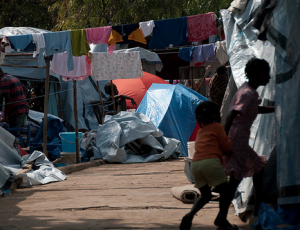The Trouble With Haiti’s Refugee Camps, Over A Year Later
 Port-au-Prince, Haiti — On a hot and dry Sunday morning, fifty people gathered inside a weathered tarp to pray. A priest led them to stand, and they sung religious chants with passion and pride. Right outside the ceremony, thousands of others spent their Sundays the same way they had every day this year. Men sat outside their tents, sometimes talking, sometimes just staring, passing time.
Port-au-Prince, Haiti — On a hot and dry Sunday morning, fifty people gathered inside a weathered tarp to pray. A priest led them to stand, and they sung religious chants with passion and pride. Right outside the ceremony, thousands of others spent their Sundays the same way they had every day this year. Men sat outside their tents, sometimes talking, sometimes just staring, passing time.
One man sat on a stool near the portable toilet stands waiting for another to give him a haircut. Three naked boys ran across the littered dirt, giggling (they did not want their baths). A mother chased them through the alleyways with a bucket of cold and soapy water. Teenage girls sat in circles on the ground, braiding one another’s hair, gossiping, counting their cans of food.
Back inside the tent, men and women concluded by wishing each other “lapè,” peace. They looked up with hope at the words written on the weathered tarp, “Foi et Joie” or “faith and joy.” And then they scattered to join their fellow residents and pass the time. This tent camp, in the middle of what used to be Port-au-Prince, was their home.
When a massive earthquake on January 12 last year, 300,000 were killed, 1.3 million were left homeless, and the international community immediately rushed to the country’s aid. Pledging millions of dollars, international leaders vowed to stay by Haiti’s side until it could stand on its own. International organizations hurried to place entire communities of homeless families in whatever spaces of land they could find.
But good intentions have not been enough to save Haitians from poverty, homelessness, sickness and violence.
Organizations used large concrete parks to house rows of plastic tarps, sheets, and tents. The tarps and tents would become home to 1.3 million displaced Haitians. While these internally displaced persons (IDP) camps were meant to be temporary, used by the international community as plans with the Haitian government were made for more solid homeless shelters, they have become for all intents and purposes, permanent homes. And, unfortunately, they’ve had serious problems since they opened; a report from the Bureau des Avocats Internationaux (BAI) found:
- Food deliveries were sporadic and arbitrary;
- Less than a quarter of people had waterproof housing;
- Most only had access to contaminated water;
- Latrines were scarce, forcing people to defecate on the ground or in bags;
- Medical care was inconsistent; and
- There were no plans in place to help residents return to self-sufficiency, so camps were without access to employment or education.
These problems persist. Most children in the camps do not go to school. Food remains scarce. Last July another survey found that severe malnourishment remains a huge problem, even as some families have resorted to feeding their children mud cakes:
- 94% had someone abstain from eating an entire day, and
- 85% obtained food by purchasing it
International and national NGOs have come into the camps to address these problems, but because they lack unlimited resources and a long-term relationship with the residents, their aid has been short-sighted, and their presence fleeting. These non-profits provide band aid solutions: providing portable latrines but no medical care, placing potable water too close to sewage.
That’s not even to mention another growing problem: rape. With no private access to showers or bathrooms, and high stress and malnutrition, nearly 1,000 women have been raped in these camps. And over half of these victims are under the age of 18.
Considering these catastrophic circumstances, what follows in this series is an attempt to understand the why of all of this. What has led to this stalemate in the efforts to rebuild Haiti? How have the international community’s efforts affected Haitian people, both in Haiti and abroad? And what remains to be done in a country of people who persevere – with hope, but without promise of revival?
Follow Nicole Kreisberg on Twitter at @NicoKrei.
[Photo By Lee Cohen]
